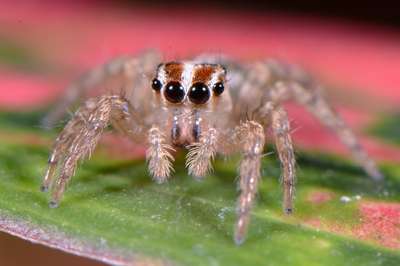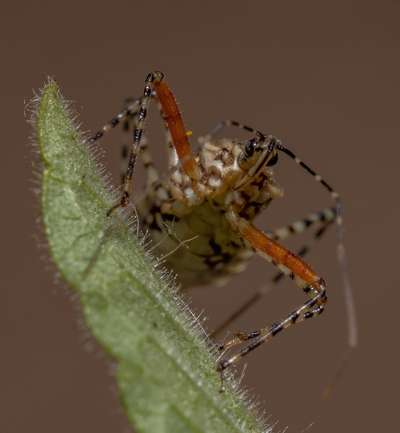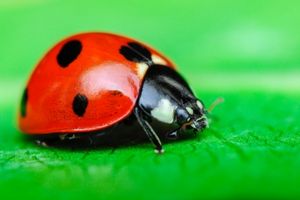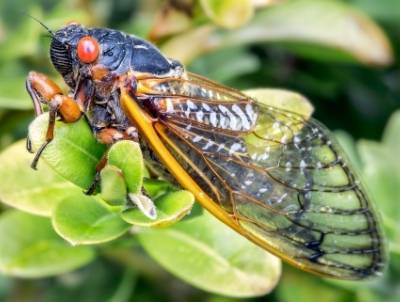A long-standing and common belief related to snakes is that you can tell whether a snake is venomous by looking at the shape of its head. A triangular-shaped head means that the snake is venomous while a more rounded and blunted shape means the snake is not. But is this really a reliable way to identify a snake as venomous?
The shape of a snake’s head is not a reliable indicator of whether it is venomous. Most venomous snakes have triangular heads but some do not. Some snake species have vaguely triangular heads as a natural consequence of snake anatomy or of defensive posturing but lack venom glands.
The notion that venomous snakes have triangular shaped heads contains an element of fact but doesn’t tell the whole story. Read on to learn about where this myth of “triangular head equals venomous snake” came from and the reasons why humans should never trust their safety to it.
Venomous snakes with triangular heads
One snake family contains the greatest number of venomous species: family Viperidae, which includes the pit vipers classified within genera Agkistrodon and Crotalus. These snakes manufacture potent venom that pose a serious, immediately life-threatening risk to humans if injected via a snakebite. They are extremely dangerous and should be treated with the utmost respect.
These snakes “prove the rule” that venomous snakes have triangular heads. Their heads do in fact look triangular when viewed from above, although some appear more rounded than angular. This is especially noticeable in one of the most dangerous snakes in North America, the eastern diamondback rattlesnake (Crotalus adamanteus), which can be found in the southeastern United States.
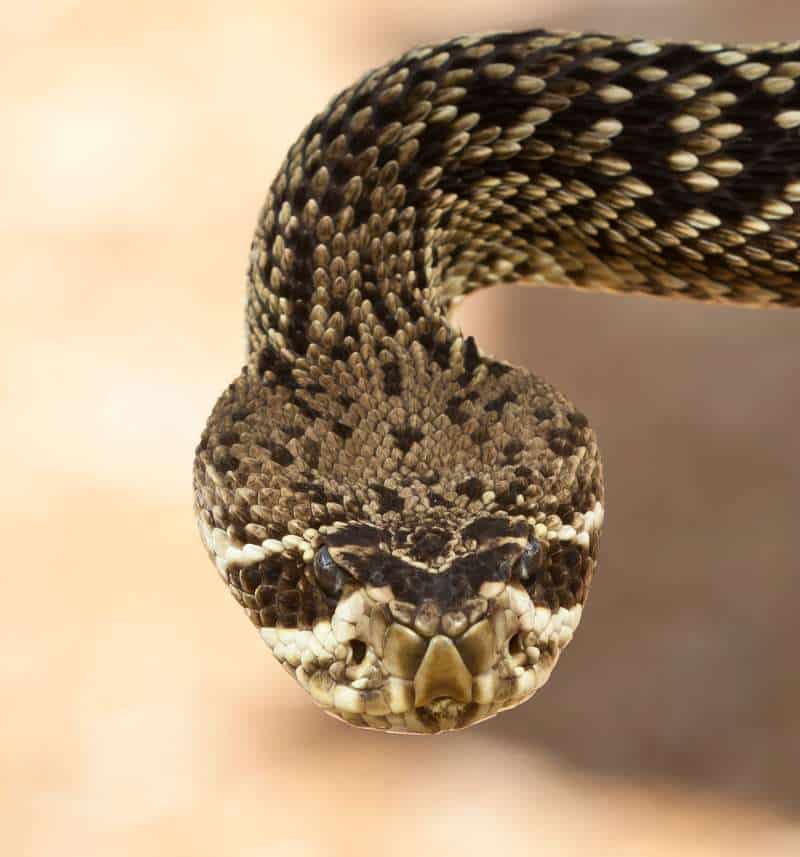
On these snakes, the snout forms one point of the triangle, and the “cheeks” extend out at angles to form the other two points; the jaw hinge area ends up wider than both the snake’s neck and its snout. Viper heads evolved this triangular shape to accommodate the venom glands which manufacture and store the venom. These glands rest on the sides of the snakes’ upper jaws, in the space formed by several of the skull bones.
| Common name | Scientific name |
| Copperhead | Agkistrodon contortrix |
| Cottonmouth | Agkistrodon piscivorus |
| Timber (or canebrake) rattlesnake | Crotalus horridus |
| Eastern diamondback rattlesnake | Crotalus adamanteus |
| Pigmy rattlesnake | Sistrurus miliarius |
While the pithy saying that a triangular head indicates a venomous snake is true for the pit vipers and vipers, it does not go far enough. The natural world, and suborder Serpentes, is too diverse to be distilled into a single saying that covers every eventuality. Exceptions exist on both sides of this “rule”; some snakes are venomous but sport heads that no one could consider triangular and some snakes are non-venomous but sport triangular heads.
Venomous snakes with rounded heads
For the purposes of this post, “venomous” refers to those snakes that could potentially pose a threat to humans.
Many snakes manufacture venom or have toxic saliva that is fatal to their prey but is too weak to dangerously affect humans. One example is the ring-necked snake (Diadophis punctatus), whose toxic saliva paralyzes frogs and lizards but is too weak to do more than cause a burning sensation in some susceptible humans (Gibbons and Dorcas 2015).
The most well-known exception to the rule of triangular head equals venomous snake is the eastern coral snake (Micrurus fulvius). Eastern coral snakes are classified in family Elapidae, which is the same family as cobras, mambas, kraits, and sea snakes. It is one of the only venomous snakes found in the southeastern United States that is not classified in family Viperidae but is legitimately dangerous to any human unlucky enough to be bitten and receive a dose of its venom.
This snake has a blunt, rounded head – the very opposite of the head shape sported by the bulkier, larger, and altogether more ill-tempered vipers and pit vipers.
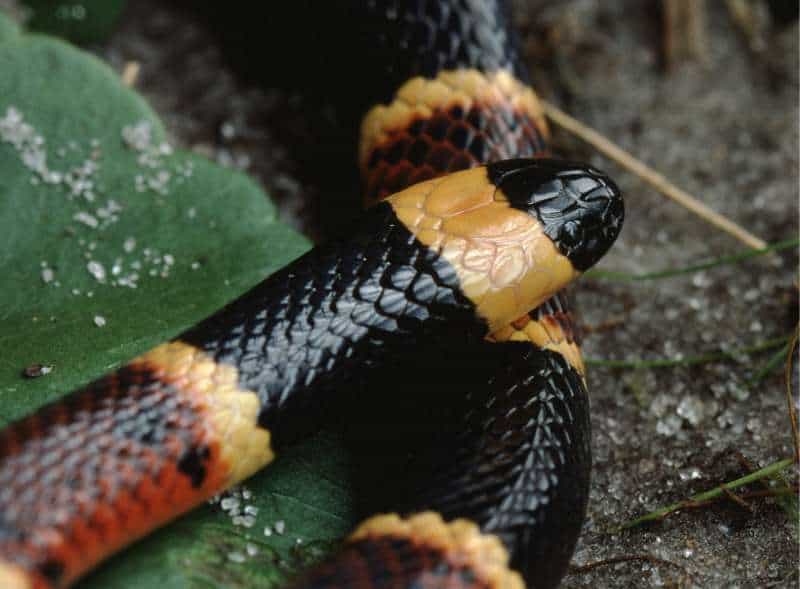
Their venom glands are smaller and more tubular and they store their venom mostly within cells as opposed to pooling it in the lumens of the venom glands like species within Viperidae (Lillywhite 2014). This anatomy takes up less space than those of their viper and pit viper cousins, which allows their heads to be more cylindrical than triangular.
While being bitten by one of these snakes is most definitely a medical emergency, they tend to be shy, retiring, and rarely encountered.
Nonvenomous snakes with triangular heads
Some snakes have heads that could be called triangular but are not venomous. Common examples in the southeastern United States are the notoriously bad-tempered water snakes of genus Nerodia and eastern garter snakes (Thamnophis sirtalis). All are colubrid snakes (Family Colubridae) and belong to sub-family Natricinidae.
Water snakes, such as the northern water snake (Nerodia sipedon) have triangular-shaped heads and bite readily, but are not venomous. When feeling threatened, they will often flatten their bodies into a defensive posture (Behler and King 2020). Since snakes are already in contact with the ground across their entire lengths, their bodies have nowhere to go but out when they hunker down. Their bodies spread and flatten, making them look bigger.
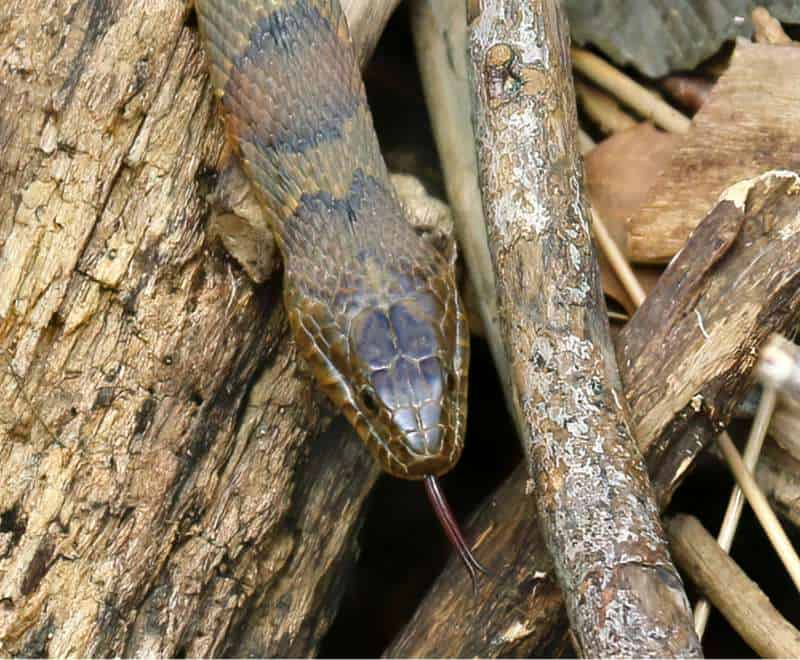
When a water snake flattens its body, it also flattens its head. Snake skulls are flexible and mobile, which allow them to swallow prey much larger than their mouths would otherwise allow. When the reptile flattens itself, the bones in its head spread out, accentuating its natural angles and making it appear more triangular than usual.
Eastern garter snakes naturally have relatively slim heads but assume the same defensive posture when threatened, flattening their heads into a more triangular shape and making themselves appear larger (Gibbons and Dorcas, 2015) and more intimidating. These long, slender snakes also bite readily so can definitely hurt humans, even if they can’t poison us with venom.
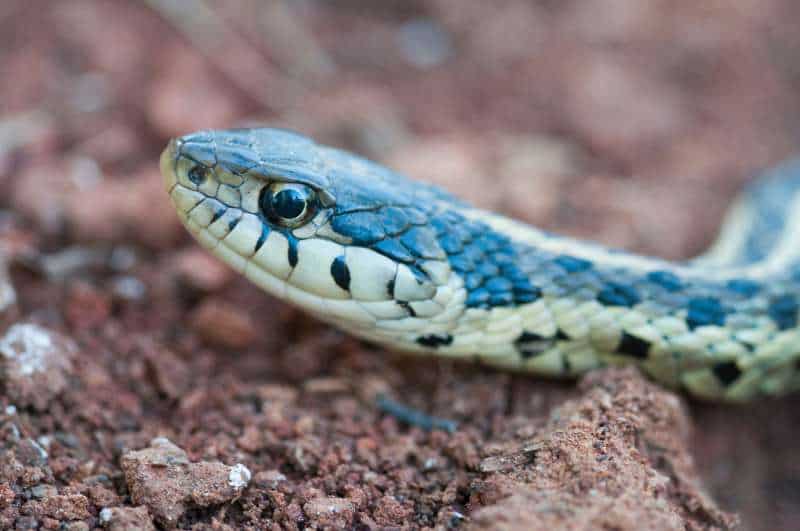
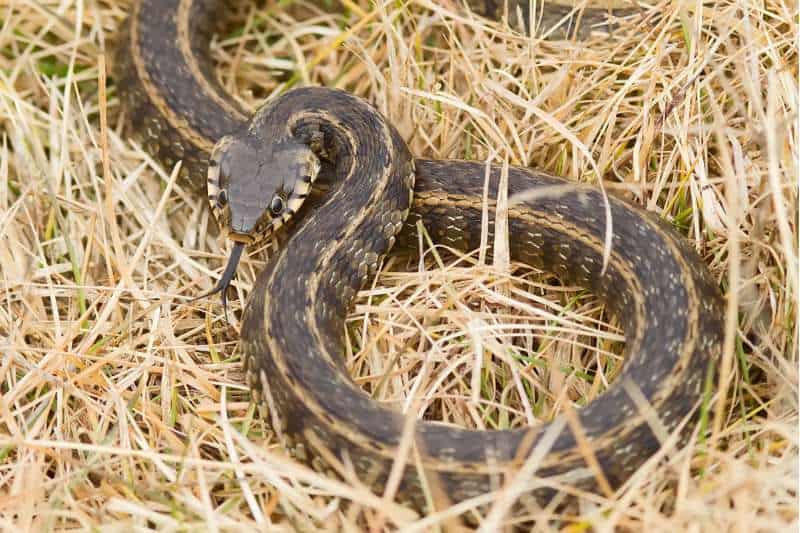
It is possible that this behavior provided these non-venomous snakes a survival advantage during their long evolutionary history. Vipers and pit vipers can be so dangerous that potential predators may forego attacking these non-venomous reptiles based purely on the visual cue given by the triangular-shaped head.
Limitations to head shape for snake identification
As discussed above, head shape is a poor indicator of whether a particular snake is venomous or not. Professional herpetologists spend years and countless hours learning to correctly identify snakes; amateur naturalists should give all snakes a wide berth, regardless of the shape of their heads.
Clearly, some snakes are absolutely capable of injecting life-threatening venom and are thus extremely dangerous. While many venomous snakes use their venom only as a last resort (it is far too valuable to their ability to hunt to be “wasted” on defense if the snake has any other option for escape), that reticence should never be assumed.
Non-venomous snakes can inflict serious wounds that require medical intervention and can cause long-term consequences. You should make every attempt to avoid being bitten and seek medical attention for every bite, regardless of whether you think venom was injected.
Leaving snakes alone is wise for personal safety but is also far more respectful to the animals in question. Wild animals – including venomous snakes – have enough to contend with from human activity these days; no snake should be forced to waste valuable resources and energy defending itself against us in the field.
If you are close enough to a snake to assess whether its head is triangular, you are far too close and being unacceptably foolish.
Accidental encounters are forgivable but never step closer deliberately to a snake to “get a better look” at the shape of its head. It simply isn’t a reliable method of determining whether the animal is venomous and even if it was, you will have placed yourself at risk to confirm it.
The better approach by far is to back slowly away from any snake you encounter and give these animals – venomous or not – the respect they deserve.
Related Now I Wonder Posts
To learn more about snakes, check out these other Now I Wonder posts:
- Can snakes swim?
- Cottonmouths vs. water moccasins: What you need to know
- Do snakes eat other snakes?
- How do snakes move around?
- Can snakes climb trees?
- Why do snakes climb trees?
- Pythons, boas, anacondas: Meet the world’s biggest snakes
- What are the world’s biggest snakes afraid of?
References
Behler JL, King FW. 2020. National Audubon Society field guide to reptiles and amphibians: North America. New York (NY): Alfred A. Knopf.
Gibbons W, Dorcas M. 2015. Snakes of the southeast. Revised ed. Athens and London. University of Georgia Press.
Lillywhite, HB. 2014. How snakes work: structure, function and behavior of the world’s snakes. Cary: Oxford University Press, Incorporated.

